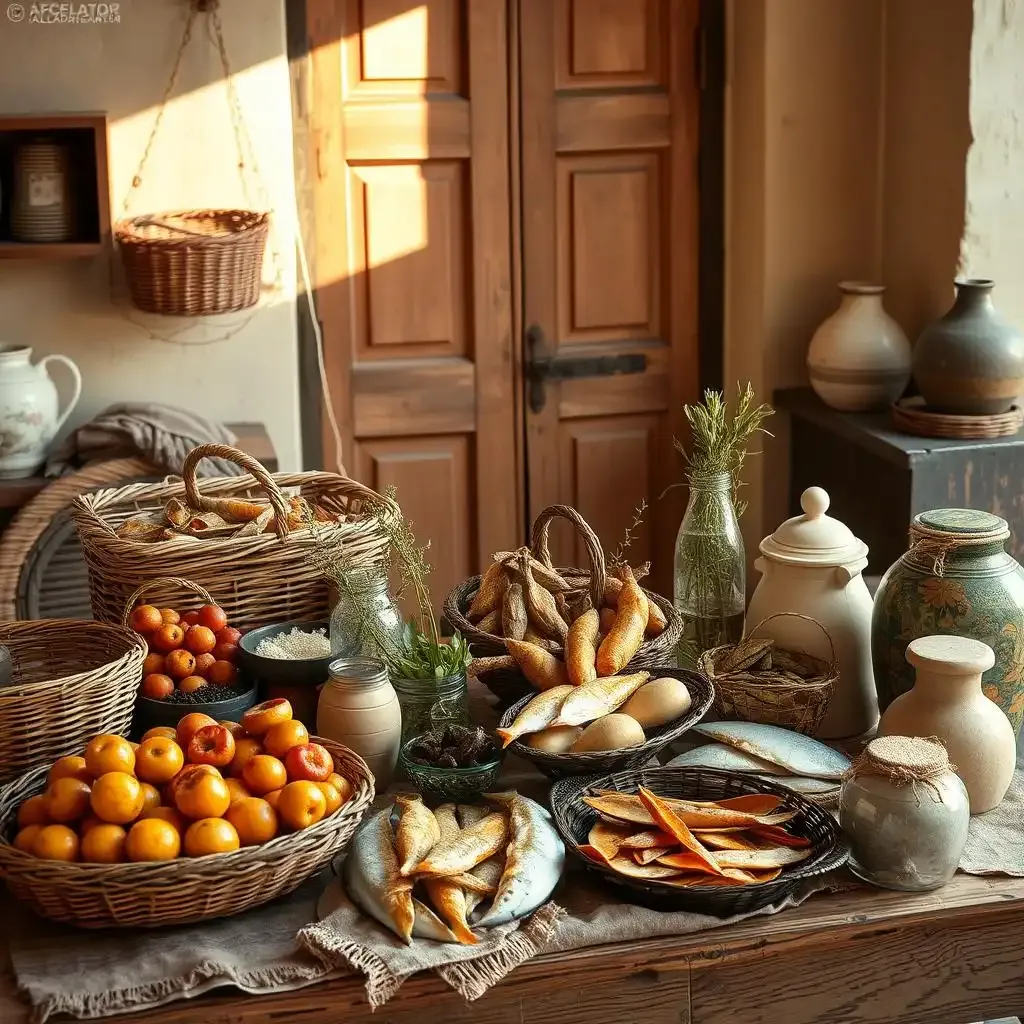Table of Contents
Have you ever wondered how ancient Mediterranean civilizations preserved their food without modern gadgets? The answer lies in their ingenious dehydration techniques, some of which have been around for thousands of years. These methods not only ensured survival but also became a cornerstone of cultural identity and sustainability. Whether you're a history buff, a food enthusiast, or someone keen on reducing waste, this article explores how Mediterranean dehydration techniques have evolved over time and continue to inspire us today. Join us as we uncover the fascinating trip of food preservation, from ancient practices to modern-day innovations.
Historical Roots | Dehydration techniques in the Mediterranean date back thousands of years, originating from ancient civilizations like Mesopotamia and Egypt. |
|---|---|
Traditional Methods | Includes sun-curing, salting, and the use of specialized facilities like ham drying rooms. |
Regional Variations | Different regions, such as Spain's Teruel and Granada, have unique climates that influence dehydration processes. |
Modern Applications | Techniques are now integrated with technology, using dehydrators for efficient food preservation and combating food waste. |
Community Impact | Workshops and festivals foster community spirit and education on traditional food preservation. |
Sustainability | Embracing these techniques supports eco-friendly practices, reducing waste and promoting local sourcing. |
Hey there! Let me tell you about the fascinating history of Mediterranean dehydration techniques. Imagine you're standing in an ancient marketplace in Egypt or Mesopotamia—it's busy with people, and everyone is busy preserving their food for the long, hot summers. Back then, people didn't have fancy gadgets like we do today; instead, they relied on the sun, salt, and clever methods to keep their food fresh. This was crucial because they didn't have refrigerators, and they needed to save their harvests to survive the lean times. Cool, right?
One of the earliest methods was sun-curing, where people would lay out their fish, herbs, or fruits under the blazing Mediterranean sun. This not only kept the food from spoiling but also made it super tasty! They also used salt—a natural preservative—to cure meats and fish. If you ever try making anchovy dip, you'll see how salt plays a big role in preserving and flavoring food. These techniques weren't just about survival; they became a huge part of their culture and identity.
Technique | Origin | Benefits |
|---|---|---|
Sun-curing | Mesopotamia & Egypt | Preserves food naturally with the sun |
Salt-curing | Ancient civilizations | Natural preservative, enhances flavor |
Air-drying | Europe & Asia | Slow process but deeply flavors the food |
Another amazing thing about these dehydration techniques is how they've evolved over time while staying true to their roots. For example, in Spain, they've developed special drying rooms for ham, where the temperature and humidity are just right to make those delicious, cured hams we love today. Think about it—this process takes months or even years! People back then were just as passionate about their food as we are now. They wanted it to taste amazing and last as long as possible.
Let's take a look at how these techniques have influenced modern cooking. If you're into making your own rosé petal jam, you might notice how drying and preserving are still essential steps to make that sweet, spreadable goodness. It's amazing how something so ancient can still be relevant in our kitchens today!
So, the next time you're enjoying cured ham or dried herbs, remember that you're tasting history. These techniques are more than just a way to preserve food; they're a bridge to our past and a reflection of how ingenious our ancestors were. And who knows? Maybe one day, you'll even try your hand at sun-curing some veggies or making your own salt-cured fish!
- Uncover how to make your own cured ham with traditional methods.
- Learn the secrets of drying herbs to enhance your cooking.
- Find out how salt has been a hero in preserving food for centuries.
Mediterranean Dehydration Techniques: Preserving Traditions

Mediterranean Dehydration Techniques Preserving Traditions
When I think about Mediterranean dehydration techniques, I'm always in awe of how these ancient methods have stood the test of time. Imagine the sun shining brightly on fish and herbs, drying them out until they're perfectly preserved. That’s basically what sun-curing is all about! It's like giving food a golden ticket to survive the harshest summers. If you're into creating your own , you'll see how similar principles apply—using the sun's strength to lock in flavors!
Sun-Curing: The Sun’s Golden Touch
Sun-curing is like letting the sun be your best friend in the kitchen. You lay out your food—whether it’s fish, herbs, or fruits—under the blazing Mediterranean sun. Over time, the sun sucks out all the moisture, leaving you with dried treasures that taste even better than before! It’s a bit magical, don’t you think?
Food | Preparation | Benefits |
|---|---|---|
Fish | Clean and season | Long-lasting and flavorful |
Herbs | Hang in bunches | Retain aromatic oils |
Fruits | Slice thinly | Sweet and chewy texture |
Think about it—how cool is it to turn fresh herbs into something that can last for months? You can sprinkle them on pasta or add a burst of flavor to your soups. And if you love dipping with , you're already using a similar technique!
Salt-Curing: Nature’s Armor
Now, let’s talk about salt-curing. This is like giving your food a superhero costume made of salt! Salt is nature’s best friend for preserving food because it stops bacteria from growing. Imagine taking a big piece of fish, sprinkling it with salt, and letting it sit until it’s nice and dry. The result? A salty, flavorful snack that can last for ages!
In Spain, they’ve taken this to another level with special ham drying rooms. These rooms are like cozy, humidity-controlled caves where ham sits for months or even years. The longer it ages, the more flavorful it becomes. If you ever try making your own , you’ll see how salt plays a starring role!
Next time you’re at the store, grab a ham and imagine all the love and care that went into preserving it. You’re tasting history every bite!
Modern Methods Meet Ancient Wisdom
Sweet Science of Modern Drying
Today, we’ve got gadgets like dehydrators that make drying food faster and more efficient. But guess what? The core idea is still the same as it was thousands of years ago. Instead of relying solely on the sun, we can now use machines to speed up the process. It’s like having a Renaissance in your kitchen!
Let me give you an example: drying herbs. You can pluck them fresh from your garden, toss them in a dehydrator, and voilà—ready-to-use seasoning in no time. If you’re into making olive tapenade, dried herbs can add a whole new layer of flavor to your dish. Talk about a win-win!
Method | Pros | Cons |
|---|---|---|
Sun-Curing | Natural, zero-cost | Weather-dependent |
Salt-Curing | Long-lasting results | Requires precise salt |
Dehydrators | Quick and consistent | Initial setup cost |
Trailing the Flavors of Time
Remember, dehydration isn't just about saving food; it's about sharing stories. When you sit down to enjoy a sun-cured almond or a salt-cured fish, you're tasting snippets of history. It’s like holding a piece of the past in your hands and sharing it with your friends and family.
So, why not give it a try? Start with something simple, like drying your own herbs or making your own salt-cured snack. You’re not just preserving food—you’re preserving memories and traditions that have been around for centuries. Pretty cool, huh?
- Find how to make with dried herbs.
- Learn the secrets of .
- Want to become a drying expert? Investigate into these dehydrating tips.
The beauty of Mediterranean dehydration techniques is that they’re not just about surviving—they’re about thriving. They’re about celebrating the good things in life and passing them down from one generation to the next. So let’s keep the tradition alive, shall we?
Modern Adaptations: How Mediterranean Methods Are Prevailing

Modern Adaptations How Mediterranean Methods Are Prevailing
The Renaissance of Dehydration Tools
Alright, so here's the thing: Mediterranean dehydration techniques are so cool, but modern tech has made them even better! Imagine taking the sun-curing method our ancestors used and giving it a turbo boost with dehydrators. These gadgets aren’t just fancy toys—they’re like having a mini sun in your kitchen, drying food faster and more consistently. If you're into making , you’ll love how perfectly dried herbs can amp up the flavor!
Method | Pros | Cons |
|---|---|---|
Dehydrators | Quick and consistent | Needs electricity |
Sun-Curing | Natural and free | Depends on weather |
Salt-Curing | Traditional and flavorful | Requires skill |
Community and Culture in the Digital Age
Here's a fun fact: Dehydration isn’t just about food—it’s about bringing people together! Today, communities worldwide are hosting workshops and potlucks, sharing Mediterranean techniques and turning them into modern-day festivals. If you’re into , you’ll see how these gatherings make the process so much more fun!
- Learn the secrets of traditional ham curing in Spain.
- Find how to make your own air-dried herbs at home.
- Join a local workshop and meet fellow food enthusiasts.
So, what’s stopping you? Whether you're drying herbs or curing ham, you're not just preserving food—you're keeping a centuries-old tradition alive. Let’s keep the Mediterranean spirit alive and pass it on to the next generation!
Community and Culture: The Modern-Day Significance
Bringing Communities Together
You know what’s even cooler than drying food? People coming together to do it! Mediterranean dehydration techniques aren’t just about the food—they’re about the people. Think of it like a big ol’ cooking party where everyone shares their secret tricks. Whether it’s curing ham in Spain or drying herbs in your backyard, these traditions bring folks together, creating a sense of belonging and shared knowledge.
If you’re into making , imagine how much more fun it would be if you were curing the anchovies with a group of friends! It’s not just about the food—it’s about the stories, the laughter, and the sense of community it builds.
Benefit | How It’s Achieved |
|---|---|
Relationship | Sharing recipes and techniques |
Education | Workshops and community events |
Tradition | Passing down skills to new generations |
Festivals and Gatherings
Let’s talk about festivals! From Spain’s ham-curing celebrations to local food fairs, there’s no shortage of events where dehydration takes center stage. These gatherings aren’t just about showcasing preserved foods—they’re about celebrating heritage and creativity. Imagine walking through a festival and sampling everything from air-dried tomatoes to cured olives! It’s like a taste of history in every bite.
And guess what? You don’t have to be an expert to join the fun. Whether you’re a pro at making or a total newbie, there’s always something to learn and share. These events are a reminder that food is more than fuel—it’s a way to connect, celebrate, and stay true to our roots.
- Check out local workshops to learn the art ofdehydration.
- Attend food festivals to sample traditional preserved foods.
- Become a dehydration warrior by hosting your own gatherings!
Embracing the Mediterranian Legacy
Mediterranean dehydrating techniques are more than just a way to preserve food; they're a testament to human ingenuity and cultural heritage. By understanding and applying these methods today, we honor our past while promoting sustainability and community. So why not give it a try? Start experimenting with dehydration in your kitchen, join a local workshop, or simply enjoy the rich flavors of traditionally preserved foods. Let's keep this ancient art alive for future generations!